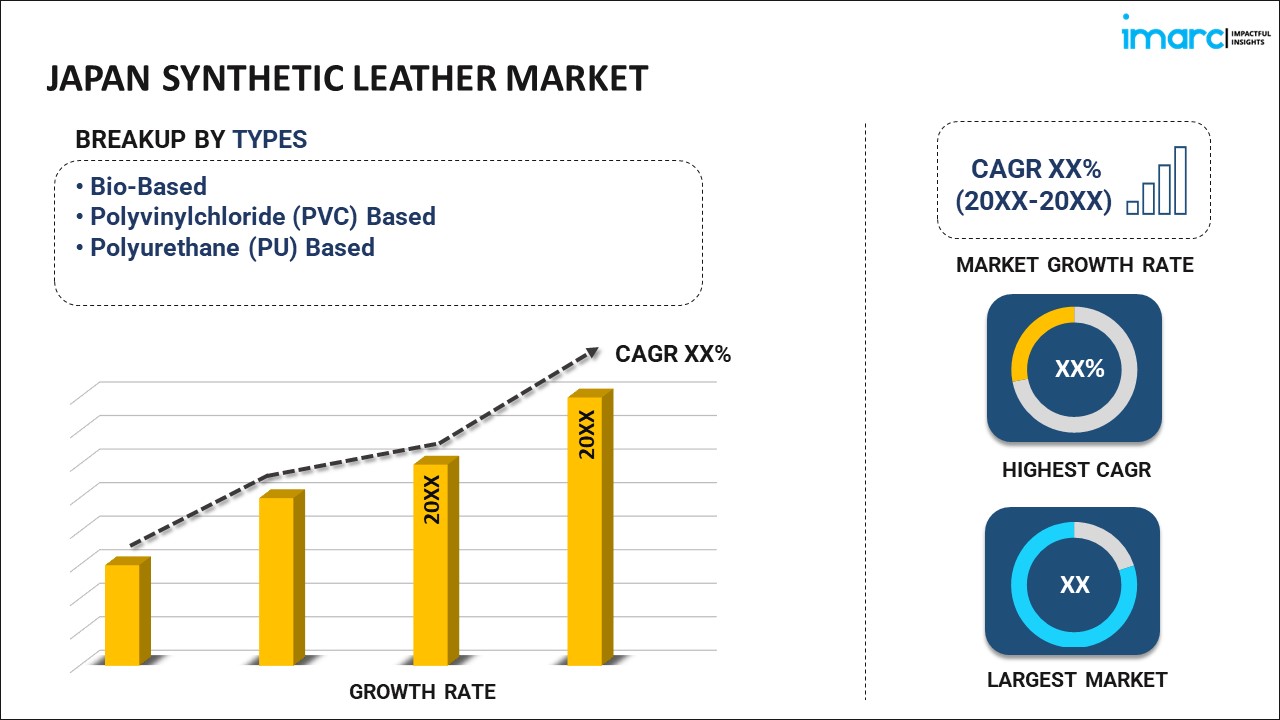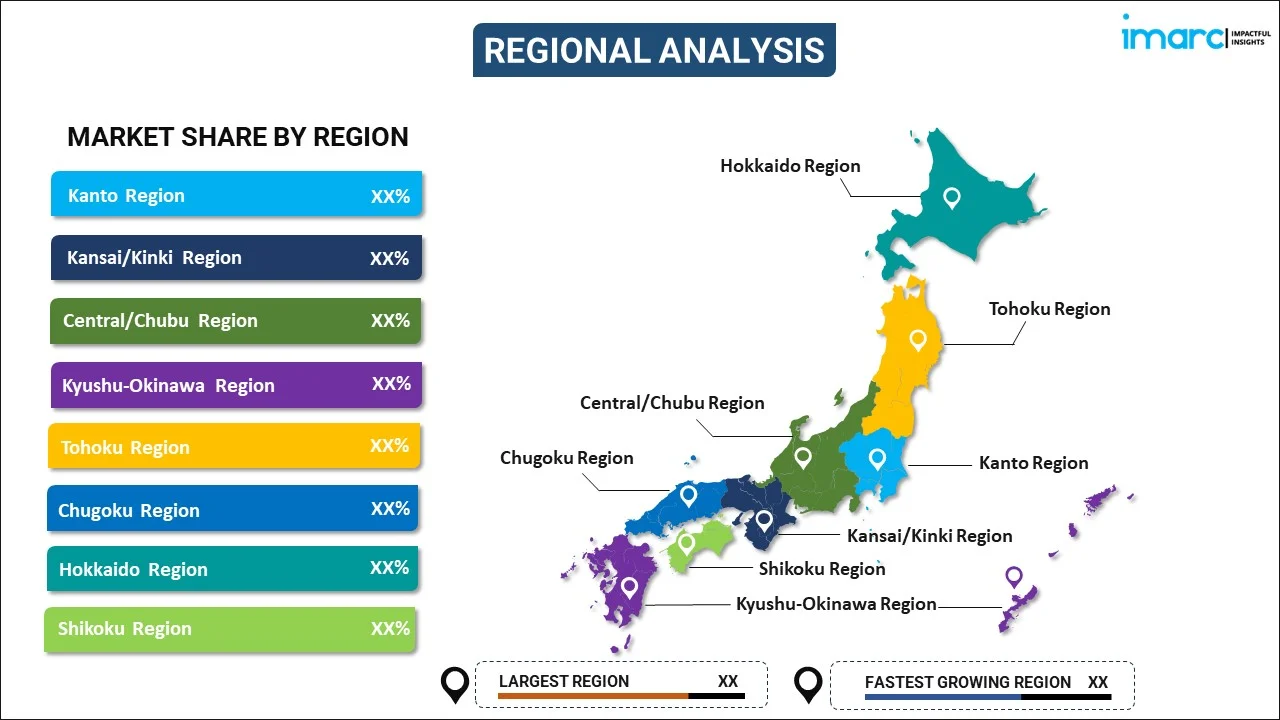
Japan Synthetic Leather Market Report by Type (Bio-Based, Polyvinylchloride (PVC) Based, Polyurethane (PU) Based), Application (Clothing, Bags, Shoes, Purses and Wallets, Accessories, Car Interiors, Belts, Sports Goods, and Others), End Use Industry (Footwear, Furniture, Automotive, Textile, Sports, Electronics, and Others), and Region 2025-2033
Market Overview:
Japan synthetic leather market size reached USD 1.51 Billion in 2024. Looking forward, IMARC Group expects the market to reach USD 2.52 Billion by 2033, exhibiting a growth rate (CAGR) of 5.9% during 2025-2033. The market is experiencing growth due to a combination of heightened ethical and environmental consciousness among consumers, as well as the implementation of rigorous regulatory measures.
|
Report Attribute
|
Key Statistics
|
|---|---|
|
Base Year
|
2024 |
|
Forecast Years
|
2025-2033 |
|
Historical Years
|
2019-2024
|
| Market Size in 2024 | USD 1.51 Billion |
| Market Forecast in 2033 | USD 2.52 Billion |
| Market Growth Rate (2025-2033) | 5.9% |
Synthetic leather serves as a synthetic substitute for traditional animal-derived leather, comprising a blend of synthetic materials like polyvinyl chloride (PVC) or polyurethane (PU) layered onto a fabric foundation. The production process involves the application of these synthetic components to replicate the appearance and texture of genuine leather, offering a broad spectrum for customization in terms of color, texture, and design. Synthetic leather carries several advantages, including its cost-effectiveness compared to genuine leather and its resistance to issues like fading, cracking, and water damage. It demands less maintenance and is regarded as a more eco-friendly alternative, as it reduces reliance on animal resources. Synthetic leather boasts versatile applications across various industries, encompassing fashion, furniture, automotive upholstery, and accessories. Within synthetic leather, two primary categories emerge: polyurethane (PU) leather and polyvinyl chloride (PVC) leather.
Japan Synthetic Leather Market Trends:
The increasing consciousness among consumers in Japan regarding animal welfare has driven a surge in demand for ethical and vegan alternatives in fashion and interior sectors. Synthetic leather, adept at replicating the visual and tactile characteristics of genuine leather, has emerged as an attractive choice. Additionally, its cost-effectiveness, extended durability, and ease of maintenance have boosted its popularity across diverse industries, including fashion, automotive, furniture, and apparel, painting a promising growth trajectory for the market. Furthermore, continuous technological advancements and innovations are elevating the quality of synthetic leather, rendering it increasingly similar in texture and appearance to genuine leather. This development is contributing to the market's expansion. Simultaneously, the adoption of eco-friendly production methods and bio-based materials is addressing sustainability concerns related to traditional synthetic leather manufacturing, further fostering market growth. Moreover, stringent global regulations governing the use of real leather due to its environmental impact, especially concerning deforestation and greenhouse gas emissions linked to livestock farming, are driving the market. Additionally, the adaptability of synthetic leather to a wide range of colors, textures, and designs enables its seamless incorporation into various styles and trends, which is expected to fuel the regional market in the coming years.
Japan Synthetic Leather Market Segmentation:
IMARC Group provides an analysis of the key trends in each segment of the market, along with forecasts at the country level for 2025-2033. Our report has categorized the market based on type, application, and end use industry.
Type Insights:

- Bio-Based
- Polyvinylchloride (PVC) Based
- Polyurethane (PU) Based
The report has provided a detailed breakup and analysis of the market based on the type. This includes bio-based, polyvinylchloride (PVC) based, and polyurethane (PU) based.
Application Insights:
- Clothing
- Bags
- Shoes
- Purses and Wallets
- Accessories
- Car Interiors
- Belts
- Sports Goods
- Others
A detailed breakup and analysis of the market based on the application have also been provided in the report. This includes clothing, bags, shoes, purses and wallets, accessories, car interiors, belts, sports goods, and others.
End Use Industry Insights:
- Footwear
- Furniture
- Automotive
- Textile
- Sports
- Electronics
- Others
The report has provided a detailed breakup and analysis of the market based on the end use industry. This includes footwear, furniture, automotive, textile, sports, electronics, and others.
Regional Insights:

- Kanto Region
- Kansai/Kinki Region
- Central/ Chubu Region
- Kyushu-Okinawa Region
- Tohoku Region
- Chugoku Region
- Hokkaido Region
- Shikoku Region
The report has also provided a comprehensive analysis of all the major regional markets, which include Kanto Region, Kansai/Kinki Region, Central/ Chubu Region, Kyushu-Okinawa Region, Tohoku Region, Chugoku Region, Hokkaido Region, and Shikoku Region.
Competitive Landscape:
The market research report has also provided a comprehensive analysis of the competitive landscape. Competitive analysis such as market structure, key player positioning, top winning strategies, competitive dashboard, and company evaluation quadrant has been covered in the report. Also, detailed profiles of all major companies have been provided.
Japan Synthetic Leather Market Report Coverage:
| Report Features | Details |
|---|---|
| Base Year of the Analysis | 2024 |
| Historical Period | 2019-2024 |
| Forecast Period | 2025-2033 |
| Units | Billion USD |
| Scope of the Report | Exploration of Historical Trends and Market Outlook, Industry Catalysts and Challenges, Segment-Wise Historical and Future Market Assessment:
|
| Types Covered | Bio-Based, Polyvinylchloride (PVC) Based, Polyurethane (PU) Based |
| Applications Covered | Clothing, Bags, Shoes, Purses and Wallets, Accessories, Car Interiors, Belts, Sports Goods, Others |
| End Use Industries Covered | Footwear, Furniture, Automotive, Textile, Sports, Electronics, Others |
| Regions Covered | Kanto Region, Kansai/Kinki Region, Central/ Chubu Region, Kyushu-Okinawa Region, Tohoku Region, Chugoku Region, Hokkaido Region, Shikoku Region |
| Customization Scope | 10% Free Customization |
| Post-Sale Analyst Support | 10-12 Weeks |
| Delivery Format | PDF and Excel through Email (We can also provide the editable version of the report in PPT/Word format on special request) |
Key Questions Answered in This Report:
- How has the Japan synthetic leather market performed so far and how will it perform in the coming years?
- What has been the impact of COVID-19 on the Japan synthetic leather market?
- What is the breakup of the Japan synthetic leather market on the basis of type?
- What is the breakup of the Japan synthetic leather market on the basis of application?
- What is the breakup of the Japan synthetic leather market on the basis of end use industry?
- What are the various stages in the value chain of the Japan synthetic leather market?
- What are the key driving factors and challenges in the Japan synthetic leather?
- What is the structure of the Japan synthetic leather market and who are the key players?
- What is the degree of competition in the Japan synthetic leather market?
Key Benefits for Stakeholders:
- IMARC’s industry report offers a comprehensive quantitative analysis of various market segments, historical and current market trends, market forecasts, and dynamics of the Japan synthetic leather market from 2019-2033.
- The research report provides the latest information on the market drivers, challenges, and opportunities in the Japan synthetic leather market.
- Porter's five forces analysis assist stakeholders in assessing the impact of new entrants, competitive rivalry, supplier power, buyer power, and the threat of substitution. It helps stakeholders to analyze the level of competition within the Japan synthetic leather industry and its attractiveness.
- Competitive landscape allows stakeholders to understand their competitive environment and provides an insight into the current positions of key players in the market.
Need more help?
- Speak to our experienced analysts for insights on the current market scenarios.
- Include additional segments and countries to customize the report as per your requirement.
- Gain an unparalleled competitive advantage in your domain by understanding how to utilize the report and positively impacting your operations and revenue.
- For further assistance, please connect with our analysts.
 Inquire Before Buying
Inquire Before Buying
 Speak to an Analyst
Speak to an Analyst
 Request Brochure
Request Brochure
 Request Customization
Request Customization




.webp)




.webp)












